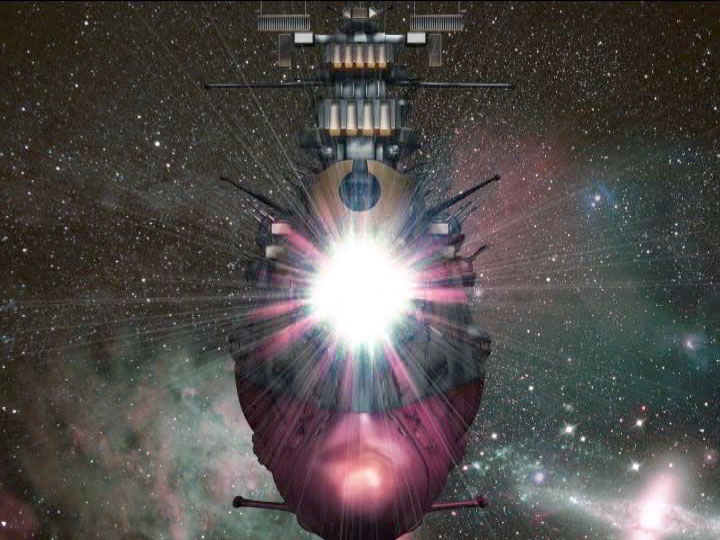
Posted on 08/01/2014 4:13:21 PM PDT by servo1969
Let me geek out on you (I love science) and explain to you the science (I love science) and why this had previously been confined to the pages of science fiction (I am a nerd; and oh Dear Sweet Bunsen-Burner Lighting Lord, do I love science).
So it's a pretty firmly established principle that every act causes, and requires, an equal and opposite reaction.
If I understand this right (did I mention I love science?), this means that any space vessel will have to carry with it an enormous amount of reaction mass.
You can't -- we think, or thought -- just push energy out the backside of a spaceship and make it go voom. (Voom is a term that we who love science use.)
You have to actually impart momentum to physical mass -- a gas, for example. You spurt the gas out of the back of the spaceship. The gas is going backwards quickly, which makes the spaceship go forwards.
Without actually ejecting mass in the opposite direction you want the spaceship to go, we think -- or thought (those of us who think about science because, oh right, we love it) -- you have no propulsion at all.
So this means that the various spaceships you see in movies are all wrong. (All wrong is a scientific term.) A real spaceship should have tremendously large tanks of reaction mass, which it uses in flight to propel it. The proportion of "tank" to actual ship should be enormous -- the actual ship part of the ship would be tiny.
Basically a real spaceship would be an enormous series of gigantic tanks, with a tiny little cockpit/living space somewhere on it like a pimple. (Pimples are small oil-filled sacs in the epidermis -- That's science!)
Not only does this look goofy, thus destroying our dreams of sleek spaceships, but it imposes considerable, considerable engineering challenges on spaceship design, as the ship would be something like 90% reaction mass.
You'd have to carry around that much mass-- and when you tried to propel yourself, you'd have to accelerate that much mass, and of course all that mass doesn't wish to be propelled and will resist you. (We call that resistance-of-mass-to-acceleration "inertia" -- now there's some deep Science for ya.)
All told, it would be so, so much easier if we were disburdened of this very inconvenient law that only a mass being ejected from the rear of the ship could propel the ship forward.
This is why science fiction often postulates "reactionless drives." The term describes a hypothetical, fanciful drive system which does not require mass to be ejected from the ship, but instead just pumps out energy.
Or something. Writers are rarely detailed about it because it's just silly.
This is -- or was -- widely believed to be simply impossible and a very silly, if nonetheless pleasing, background conceit of science fiction.
Or science fantasy, really, when you take into account a reactionless drive is physically (or should I say physics-ally) impossible. (Did you see that? That was a science joke.)
But is it impossible?
Short answer: Yes, it's impossible.
Long answer: But maybe not.
Nasa is a major player in space science, so when a team from the agency this week presents evidence that "impossible" microwave thrusters seem to work, something strange is definitely going on. Either the results are completely wrong, or Nasa has confirmed a major breakthrough in space propulsion.British scientist Roger Shawyer has been trying to interest people in his EmDrive for some years through his company SPR Ltd. Shawyer claims the EmDrive converts electric power into thrust, without the need for any propellant by bouncing microwaves around in a closed container. He has built a number of demonstration systems, but critics reject his relativity-based theory and insist that, according to the law of conservation of momentum, it cannot work.
...
[A] US scientist, Guido Fetta, has built his own propellant-less microwave thruster, and managed to persuade Nasa to test it out. The test results were presented on July 30 at the 50th Joint Propulsion Conference in Cleveland, Ohio. Astonishingly enough, they are positive.
Now I gotta tell you: Frankly, I think this is all an error, and it will soon be disproven. I think there's some artifact going on here, something no one is checking.
I think it is true, and will remain true, that you have to shoot propellant out your rear to go forward.
But this does have one nice effect:
You can now read science fiction stories postulating reactionless drives and consider them plausible, rather than fantasy.
For now.
Until they disprove it all.
Thanks to various members of the blog's I Love Science/I am a Nerd team, @conarticritic, @rdbrewer4, and @comradearthur.
The ion drive will predate warp drive

Newton Law of Motion #1 violated
Either that or Second Law of Thermodynics violated.
Other than that: perfect like cold fusion in Ytah
Dynamics
Sorry
Utah
Okay, step away from the keyboard, sir.
Slinky also makes a wonderful toy
Another Muslim invention!


hell, anybody who’s ever scraped out a jeffries tube knows that...
People used to mock Robert Goddard with his ‘loony’ ideas about spaceflight. You’d think people would be more open to new ideas but it seems things never change.
If microwave propulsion is proven to work despite defying previously accepted orthodoxies about physics then it simply means there need to be new orthodoxies about physics.
I believe it is possible, does not violate the laws of motion or thermodynamics, and is relatively straight forward. Does that make me a barking moonbat?

“Shawyer claims the EmDrive converts electric power into thrust, without the need for any propellant by bouncing microwaves around in a closed container. He has built a number of demonstration systems, but critics reject his relativity-based theory and insist that, according to the law of conservation of momentum, it cannot work.”
It would be interesting to see exactly how this guys “relativity-based theory” works. After all, relativistically, the microwave energy is equivalent to mass, but you should still need to shoot a whole lot of microwaves out the back of the ship in order to generate any forward thrust.
Just bouncing microwaves around in a box would seem to achieve nothing. One impact on one side might move the box infintesimally forward, but the reflection hitting another side would then impart momentum in another direction, and in the aggregate, it should all negate and result in no motion at all.
The only way I can conceive of this working is if you could direct the microwave impacts to only hit the front side of the box. This would require catching any reflecting photons and redirecting them back at the front side, without letting them strike any other surface to impart their momentum. Some sort of non-physical system, like a magnetic containment field, might do the trick, but I have a feeling that there is a “catch” I am not thinking of that would make even that solution not work.
As soon as they said, convert electricity, I stopped.
Where does the electricity come from? At best perfect nuclear conversion of mass to energy.
Try running the numbers for a machine to get to say 90% light. It is 100,000 fuel to payload ratio. Then there is slowing down and return.
It would be awesome if it is true. Humans would literally OWN the solar system. Probably not beyond it for a long time though.
“If microwave propulsion is proven to work despite defying previously accepted orthodoxies about physics then it simply means there need to be new orthodoxies about physics.”
But the science is settled! There is a consensus! What are you, some kind of denier??
LOL ;)
Disclaimer: Opinions posted on Free Republic are those of the individual posters and do not necessarily represent the opinion of Free Republic or its management. All materials posted herein are protected by copyright law and the exemption for fair use of copyrighted works.